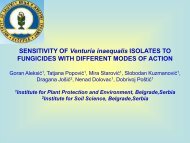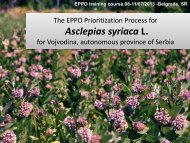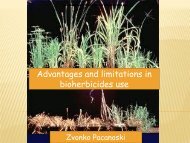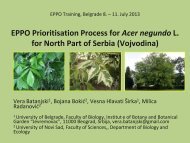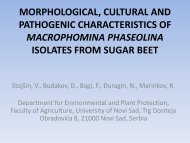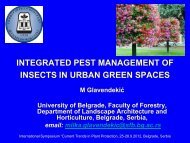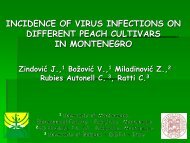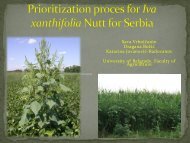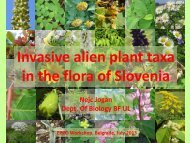kvalitet
Vol.55 - Izbis
Vol.55 - Izbis
- No tags were found...
Create successful ePaper yourself
Turn your PDF publications into a flip-book with our unique Google optimized e-Paper software.
18 Jelena Latinović, Zora Vučinić<br />
ECOLOGICAL AND EPIDEMIOLOGICAL FEATURES<br />
AND CONTROL POSSIBILITIES OF COLLETOTRICHUM<br />
GLOEOSPORIOIDES (PENZ.) PENZ. ET SACC. CAUSAL<br />
AGENT OF OLIVE ANTHRACNOSE<br />
JELENA LATINOVIĆ, ZORA VUČINIĆ<br />
University of Montenegro, Biotechnical Institute, Podgorica<br />
Summary<br />
Olive anthracnose, caused by Colletotrichum gloeosporioides (Penz.) Penz.<br />
& Sacc., has been established in Montenegro several years ago. The results of ecological<br />
and epidemiological examinations are presented and control possibilities<br />
of the disease were discussed in this paper.<br />
Optimal temperature for growth of the fungus isolates is 25 ºC, while there is<br />
no fungal growth at 3° and 34 ºC. The growth of the isolates was the most intensive<br />
on constant darkness, but the sporulation of the fungus was the most abundant<br />
in conditions of UV light.<br />
Mummified infected olive fruits, which are left to hang on branches, as well<br />
as infected fruits dropped on the soil surface, represent the permanent source of<br />
inoculum. Infected fruits dug into soil on depth of 10-15 cm cannot serve as inoculum<br />
for realization of infections in the following year. Contaminated soil cannot<br />
be the source of inoculum in the next year, because the parasite is not sustainable<br />
in the form of mycelium throughout 12 months.<br />
Since the olive fruits are in stage of maturity in October and November in<br />
overall conditions in Montenegro, these two months could be considered as critical<br />
period for appearance and spreading of the disease, if the climatic factors, primarily<br />
rainfall and temperature are convenient for realization of infection, which<br />
was the case during 1997, 1998 and 1999.<br />
Considering these results, in control of the disease the agrotechnical measures<br />
are very valuable, primarily plowing into the soil or destroying of infected<br />
plant material, as well as adequate pruning.<br />
Key words: olive, anthracnose, Colletotrichum gloeosporioides, Montenegro,<br />
ecology and epidemiology<br />
Plant Protection: Vol. 55 (1-4), No 247-250, 5-18, 2004, Belgrade<br />
(Received: 15.02.2006.)<br />
(Accepted: 08.08.2007)



